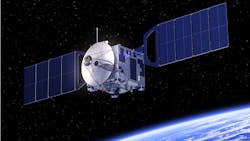Satellite communications (satcom) technology is moving far beyond the simple reception of video from orbiting geosynchronous satellites and into full bidirectional mobile satcom services. To accomplish this at Ka-band frequencies, efficient antenna designs are needed for mobile satcom terminals. Researchers from the RF and Microwave Research Laboratory at the Technische Universitat Ilmenau (Ilmenau, Germany) and the Fraunhofer Institute for Integrated Circuits IIS, Design Automation Division EAS (Dresden, Germany) attempted to compare two different Ka-band antenna terminal setups for mobile satcom applications. The two antennas traded size for performance: one was a larger, high-gain antenna, the other a lower-gain, lower-profile antenna.
The researchers point out the growing interest in Ka-band frequencies at 29.5 to 30.0 GHz for uplinks and 19.7 to 20.2 GHz for downlinks because of their healthy capacity and compact terminal antennas. In emergency situations where terrestrial communications systems may not be available or reliable, the use of geosynchronous satellites can provide a means of communications. The two antenna designs explore the classic tradeoff of size for performance. The larger of the two designs is a Cassegrain double-reflector antenna mounted on a mechanically adjusted, two-axis positioner on a carrier vehicle. The reflector diameter is 60 cm, but it provides large gain of about 40 dBi in support of high data rates for bidirectional satcom links. While moving, the antenna tracks satellite direction by means of multimode monopulse tracking. It can be mounted on large vehicles, such as pickup trucks.
The smaller antenna is designed for greater mobility, with a maximum height of only 15 cm. The smaller profile and size yields less gain, at about 20 dBi, and a correspondingly broader beamwidth. The low profile of the antenna design makes possible a compact satellite terminal outdoor unit (ODU) with a mechanical azimuth positioned that operates effectively while maintaining the aforementioned height, even when the vehicle is in motion. The design was evaluated by means of an antenna ODU demonstrator capable of adjusting azimuth for both uplink and downlink operations. In contrast to the larger, high-gain antenna, this low-profile satcom antenna is suitable for mounting on smaller vehicles, including standard automobiles. See “Ka-Band User Terminal Antennas for Satellite Communications,” IEEE Antennas & Propagation Magazine, February 2016, p. 76.
Looking for parts? Go to SourceESB.
This file type includes high resolution graphics and schematics when applicable.
About the Author
Jack Browne
Technical Contributor
Jack Browne, Technical Contributor, has worked in technical publishing for over 30 years. He managed the content and production of three technical journals while at the American Institute of Physics, including Medical Physics and the Journal of Vacuum Science & Technology. He has been a Publisher and Editor for Penton Media, started the firm’s Wireless Symposium & Exhibition trade show in 1993, and currently serves as Technical Contributor for that company's Microwaves & RF magazine. Browne, who holds a BS in Mathematics from City College of New York and BA degrees in English and Philosophy from Fordham University, is a member of the IEEE.

